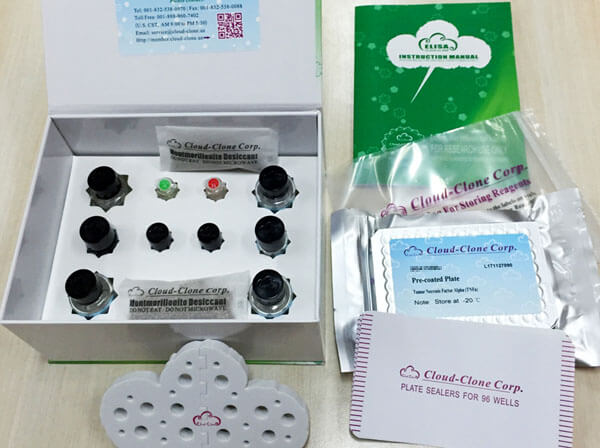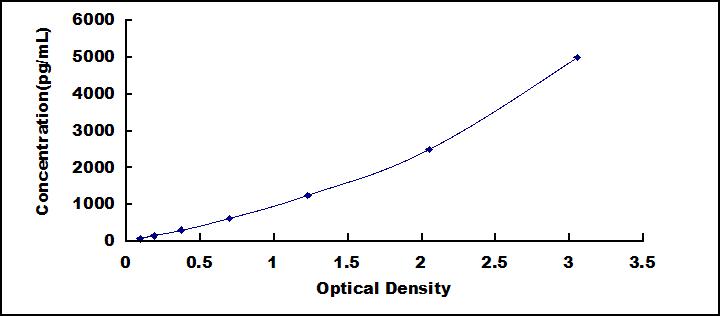ELISA Kit for Glial Cell Line Derived Neurotrophic Factor (GDNF) 

ATF1; ATF2; HFB1-GDNF; Astrocyte-Derived Trophic Factor; Glial Derived Neurotrophic Factor
- UOM
- FOB US$ 426.00 US$ 608.00 US$ 2,736.00 US$ 5,168.00 US$ 42,560.00
- Quantity
Overview
Properties
- Product No.SEA043Ra
- Organism SpeciesRattus norvegicus (Rat) Same name, Different species.
- ApplicationsEnzyme-linked immunosorbent assay for Antigen Detection.
Research use only - DownloadInstruction Manual
- CategoryCytokineApoptosisNeuro science
Sign into your account
Share a new citation as an author
Upload your experimental result
Review

Contact us
Please fill in the blank.
Recovery
Matrices listed below were spiked with certain level of recombinant Glial Cell Line Derived Neurotrophic Factor (GDNF) and the recovery rates were calculated by comparing the measured value to the expected amount of Glial Cell Line Derived Neurotrophic Factor (GDNF) in samples.
| Matrix | Recovery range (%) | Average(%) |
| serum(n=5) | 95-105 | 101 |
| EDTA plasma(n=5) | 96-103 | 101 |
| heparin plasma(n=5) | 93-105 | 99 |
Precision
Intra-assay Precision (Precision within an assay): 3 samples with low, middle and high level Glial Cell Line Derived Neurotrophic Factor (GDNF) were tested 20 times on one plate, respectively.
Inter-assay Precision (Precision between assays): 3 samples with low, middle and high level Glial Cell Line Derived Neurotrophic Factor (GDNF) were tested on 3 different plates, 8 replicates in each plate.
CV(%) = SD/meanX100
Intra-Assay: CV<10%
Inter-Assay: CV<12%
Linearity
The linearity of the kit was assayed by testing samples spiked with appropriate concentration of Glial Cell Line Derived Neurotrophic Factor (GDNF) and their serial dilutions. The results were demonstrated by the percentage of calculated concentration to the expected.
| Sample | 1:2 | 1:4 | 1:8 | 1:16 |
| serum(n=5) | 91-101% | 90-98% | 82-95% | 93-101% |
| EDTA plasma(n=5) | 78-103% | 79-94% | 79-95% | 94-103% |
| heparin plasma(n=5) | 81-90% | 89-103% | 99-105% | 92-105% |
Stability
The stability of kit is determined by the loss rate of activity. The loss rate of this kit is less than 5% within the expiration date under appropriate storage condition.
To minimize extra influence on the performance, operation procedures and lab conditions, especially room temperature, air humidity, incubator temperature should be strictly controlled. It is also strongly suggested that the whole assay is performed by the same operator from the beginning to the end.
Reagents and materials provided
| Reagents | Quantity | Reagents | Quantity |
| Pre-coated, ready to use 96-well strip plate | 1 | Plate sealer for 96 wells | 4 |
| Standard | 2 | Standard Diluent | 1×20mL |
| Detection Reagent A | 1×120µL | Assay Diluent A | 1×12mL |
| Detection Reagent B | 1×120µL | Assay Diluent B | 1×12mL |
| TMB Substrate | 1×9mL | Stop Solution | 1×6mL |
| Wash Buffer (30 × concentrate) | 1×20mL | Instruction manual | 1 |
Assay procedure summary
1. Prepare all reagents, samples and standards;
2. Add 100µL standard or sample to each well. Incubate 1 hours at 37°C;
3. Aspirate and add 100µL prepared Detection Reagent A. Incubate 1 hour at 37°C;
4. Aspirate and wash 3 times;
5. Add 100µL prepared Detection Reagent B. Incubate 30 minutes at 37°C;
6. Aspirate and wash 5 times;
7. Add 90µL Substrate Solution. Incubate 10-20 minutes at 37°C;
8. Add 50µL Stop Solution. Read at 450nm immediately.

Test principle
The test principle applied in this kit is Sandwich enzyme immunoassay. The microtiter plate provided in this kit has been pre-coated with an antibody specific to Glial Cell Line Derived Neurotrophic Factor (GDNF). Standards or samples are then added to the appropriate microtiter plate wells with a biotin-conjugated antibody specific to Glial Cell Line Derived Neurotrophic Factor (GDNF). Next, Avidin conjugated to Horseradish Peroxidase (HRP) is added to each microplate well and incubated. After TMB substrate solution is added, only those wells that contain Glial Cell Line Derived Neurotrophic Factor (GDNF), biotin-conjugated antibody and enzyme-conjugated Avidin will exhibit a change in color. The enzyme-substrate reaction is terminated by the addition of sulphuric acid solution and the color change is measured spectrophotometrically at a wavelength of 450nm ± 10nm. The concentration of Glial Cell Line Derived Neurotrophic Factor (GDNF) in the samples is then determined by comparing the O.D. of the samples to the standard curve.
Giveaways
Increment services
-
 Single-component Reagents of Assay Kit
Single-component Reagents of Assay Kit
-
 Lysis Buffer Specific for ELISA / CLIA
Lysis Buffer Specific for ELISA / CLIA
-
 Quality Control of Kit
Quality Control of Kit
-
 ELISA Kit Customized Service
ELISA Kit Customized Service
-
 Disease Model Customized Service
Disease Model Customized Service
-
 Serums Customized Service
Serums Customized Service
-
 TGFB1 Activation Reagent
TGFB1 Activation Reagent
-
 Real Time PCR Experimental Service
Real Time PCR Experimental Service
-
 Streptavidin
Streptavidin
-
 Fast blue Protein Stain solution
Fast blue Protein Stain solution
-
 Single-component Reagents of FLIA Kit
Single-component Reagents of FLIA Kit
-
 Streptavidin-Agarose Beads
Streptavidin-Agarose Beads
Citations
- Efficient Generation of Functionally Active Spinal Cord Neurons from Spermatogonial Stem Cellspubmed:27566610
- Safflower Extract and Aceglutamide Injection Promoting Recovery of Peripheral Innervations via Vascular Endothelial Growth Factor-B Signaling in Diabetic MicePMC5717862
- Acupuncture Alters Pro-infl ammatory Cytokines in the Plasma of Maternally Separated Rat Pupspubmed:28986807
- GDNF serum levels are found to be lower in opioid-maintained patientsISSN 2531-4122
- Effects of 220 MHz Pulsed Modulated Radiofrequency Field on the Sperm Quality in RatsPubmed: 30974849
- The Effects of Nordic Walking With Poles With an Integrated Resistance Shock Absorber on Cognitive Abilities and Cardiopulmonary Efficiency in …Pubmed: 33192480
- Increased serum brain-derived neurotrophic factor and adrenocorticotropic hormone levels are associated with obsessive compulsive disorder in medication?free?¡33389158
- The effect of biodegradable silk fibroin-based scaffolds containing glial cell line-derived neurotrophic factor (GDNF) on the corneal regeneration process34119551
- Silymarin constrains diacetyl-prompted oxidative stress and neuroinflammation in rats: involvements of Dyn/GDNF and MAPK signaling pathwayPubmed:35366745
- Umbilical cord-derived mesenchymal stem cell conditioned medium reverses neuronal oxidative injury by inhibition of TRPM2 activation and the JNK signaling …Pubmed:35585377








